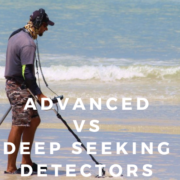Guide:Difference Between Advanced vs Deep Seeking Detectors
-
Price
Advanced level gold detectors lie in the price range of about 120,000 PKR to about 225,000 PKR which is a moderate amount for serious level equipment with features entertaining professional treasure hunters. But the Deep seeking detectors have higher prices starting from 350,000 PKR and going to a maximum of 700,000 PKR with advanced technological developments renovating the whole machine and rendering it more effective.
-
Hardware
Starting from 11 inches and extending towards coils of 15 inches, advanced level gold detectors are still limited to inches where the deep seek detectors transition to the higher unit, meters, having a diameter of 1-2 meters. Both of them have upgradable coils, with built-in pinpointers available and very heavy in weight.
-
Technology
Advanced level detectors come with DD coil technology and the detectors have VLF technology. However, the deep seek detectors are based on Pulse Induction technology, which is relatively advanced technology.
-
Specifications
Advanced level detectors are able to detect the presence of metallic objects at the range of 3 to 5 feet underground, whereas the deep seek detectors can detect at almost double the range of the former, which is 6 to 10 feet approximately. Lastly Both of them have an option of ground balance, discrimination as well as depth indicators. But some of the deep seek detectors may not have the option of depth indicators.
-
Output Mode
In addition both advanced and deep seeking gold detectors come with digital display options only, where a LED display is accompanied or built inside the control unit of the device. Additionally advanced level detectors do not have 3D graphs but the deep seek detectors have the option of colorful graphical displays for better interpretation o the data acquired from the field. Some external devices with the installation of applications or software allow the access of the gold detector data on a backlit display if it is not already built-in.
-
Warranty and Spare Parts
Moreover the advanced level and deep seeking gold detectors have an option of availing warranty claim. After the purchase and use of device starting from 1 year and extending towards 5 years along with spare parts which can be easily requested from the official distributors.
Specifications Summary and Comparison
| Specs | Advanced Level Detectors | Deep Seeking Detectors |
| Price | 120K-225K | 350K-700K |
| Depth | 3-5 feet | 6-10 feet |
| Ground Balance | Yes | Yes |
| Pinpointer | Yes | Yes |
| Coil Size | 11-15 inches | 1-2 meters |
| Upgradable | Yes | Yes |
| Downgradable | Yes | Yes |
| Coil Technology | DD | – |
| Detector Technology | VLF | Pulse Induction |
| Discrimination | Yes | Yes |
| Depth Indicator | Yes | Some |
| 3D Graphs | No | Yes |
| Output Mode | Digital | Digital |
| Weight | More | More |
| Warranty | Yes | Yes |
| Spare Parts | Yes | Yes |
| Waterproofing | No |


 03111444615
03111444615